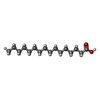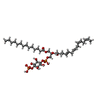+ Open data
Open data
- Basic information
Basic information
| Entry | Database: PDB / ID: 8jt6 | ||||||
|---|---|---|---|---|---|---|---|
| Title | 5-HT1A-Gi in complex with compound (R)-IHCH-7179 | ||||||
 Components Components |
| ||||||
 Keywords Keywords | MEMBRANE PROTEIN / Serotonin receptor / 5-HT1AR / Gi-protein | ||||||
| Function / homology |  Function and homology information Function and homology informationregulation of serotonin secretion / Gi/o-coupled serotonin receptor activity / regulation of hormone secretion / regulation of behavior / receptor-receptor interaction / Serotonin receptors / serotonin receptor activity / G protein-coupled serotonin receptor activity / regulation of dopamine metabolic process / serotonin receptor signaling pathway ...regulation of serotonin secretion / Gi/o-coupled serotonin receptor activity / regulation of hormone secretion / regulation of behavior / receptor-receptor interaction / Serotonin receptors / serotonin receptor activity / G protein-coupled serotonin receptor activity / regulation of dopamine metabolic process / serotonin receptor signaling pathway / neurotransmitter receptor activity / serotonin metabolic process / serotonin binding / gamma-aminobutyric acid signaling pathway / exploration behavior / G protein-coupled receptor signaling pathway, coupled to cyclic nucleotide second messenger / regulation of vasoconstriction / behavioral fear response / adenylate cyclase inhibitor activity / positive regulation of protein localization to cell cortex / T cell migration / Adenylate cyclase inhibitory pathway / D2 dopamine receptor binding / response to prostaglandin E / adenylate cyclase regulator activity / G protein-coupled serotonin receptor binding / adenylate cyclase-inhibiting serotonin receptor signaling pathway / cellular response to forskolin / regulation of mitotic spindle organization / Regulation of insulin secretion / positive regulation of cholesterol biosynthetic process / electron transport chain / negative regulation of insulin secretion / G protein-coupled receptor binding / response to peptide hormone / adenylate cyclase-inhibiting G protein-coupled receptor signaling pathway / adenylate cyclase-modulating G protein-coupled receptor signaling pathway / centriolar satellite / G-protein beta/gamma-subunit complex binding / Olfactory Signaling Pathway / Activation of the phototransduction cascade / G beta:gamma signalling through PLC beta / Presynaptic function of Kainate receptors / Thromboxane signalling through TP receptor / G protein-coupled acetylcholine receptor signaling pathway / Activation of G protein gated Potassium channels / Inhibition of voltage gated Ca2+ channels via Gbeta/gamma subunits / G-protein activation / Prostacyclin signalling through prostacyclin receptor / G beta:gamma signalling through CDC42 / Glucagon signaling in metabolic regulation / G beta:gamma signalling through BTK / Synthesis, secretion, and inactivation of Glucagon-like Peptide-1 (GLP-1) / ADP signalling through P2Y purinoceptor 12 / photoreceptor disc membrane / Sensory perception of sweet, bitter, and umami (glutamate) taste / Glucagon-type ligand receptors / Adrenaline,noradrenaline inhibits insulin secretion / GDP binding / Vasopressin regulates renal water homeostasis via Aquaporins / Glucagon-like Peptide-1 (GLP1) regulates insulin secretion / G alpha (z) signalling events / cellular response to catecholamine stimulus / ADORA2B mediated anti-inflammatory cytokines production / ADP signalling through P2Y purinoceptor 1 / G beta:gamma signalling through PI3Kgamma / Cooperation of PDCL (PhLP1) and TRiC/CCT in G-protein beta folding / adenylate cyclase-activating dopamine receptor signaling pathway / GPER1 signaling / Inactivation, recovery and regulation of the phototransduction cascade / cellular response to prostaglandin E stimulus / G-protein beta-subunit binding / heterotrimeric G-protein complex / G alpha (12/13) signalling events / sensory perception of taste / extracellular vesicle / signaling receptor complex adaptor activity / Thrombin signalling through proteinase activated receptors (PARs) / retina development in camera-type eye / G protein activity / GTPase binding / Ca2+ pathway / fibroblast proliferation / midbody / High laminar flow shear stress activates signaling by PIEZO1 and PECAM1:CDH5:KDR in endothelial cells / cell cortex / G alpha (i) signalling events / G alpha (s) signalling events / phospholipase C-activating G protein-coupled receptor signaling pathway / G alpha (q) signalling events / chemical synaptic transmission / Hydrolases; Acting on acid anhydrides; Acting on GTP to facilitate cellular and subcellular movement / Ras protein signal transduction / periplasmic space / electron transfer activity / Extra-nuclear estrogen signaling / cell population proliferation / ciliary basal body / G protein-coupled receptor signaling pathway / iron ion binding Similarity search - Function | ||||||
| Biological species |  Homo sapiens (human) Homo sapiens (human)  | ||||||
| Method | ELECTRON MICROSCOPY / single particle reconstruction / cryo EM / Resolution: 3 Å | ||||||
 Authors Authors | Chen, Z. / Xu, P. / Huang, S. / Xu, H.E. / Wang, S. | ||||||
| Funding support |  China, 1items China, 1items
| ||||||
 Citation Citation |  Journal: Cell / Year: 2024 Journal: Cell / Year: 2024Title: Flexible scaffold-based cheminformatics approach for polypharmacological drug design. Authors: Zhangcheng Chen / Jing Yu / Huan Wang / Peiyu Xu / Luyu Fan / Fengxiu Sun / Sijie Huang / Pei Zhang / He Huang / Shuo Gu / Bowen Zhang / Yue Zhou / Xiaobo Wan / Gang Pei / H Eric Xu / ...Authors: Zhangcheng Chen / Jing Yu / Huan Wang / Peiyu Xu / Luyu Fan / Fengxiu Sun / Sijie Huang / Pei Zhang / He Huang / Shuo Gu / Bowen Zhang / Yue Zhou / Xiaobo Wan / Gang Pei / H Eric Xu / Jianjun Cheng / Sheng Wang /  Abstract: Effective treatments for complex central nervous system (CNS) disorders require drugs with polypharmacology and multifunctionality, yet designing such drugs remains a challenge. Here, we present a ...Effective treatments for complex central nervous system (CNS) disorders require drugs with polypharmacology and multifunctionality, yet designing such drugs remains a challenge. Here, we present a flexible scaffold-based cheminformatics approach (FSCA) for the rational design of polypharmacological drugs. FSCA involves fitting a flexible scaffold to different receptors using different binding poses, as exemplified by IHCH-7179, which adopted a "bending-down" binding pose at 5-HTR to act as an antagonist and a "stretching-up" binding pose at 5-HTR to function as an agonist. IHCH-7179 demonstrated promising results in alleviating cognitive deficits and psychoactive symptoms in mice by blocking 5-HTR for psychoactive symptoms and activating 5-HTR to alleviate cognitive deficits. By analyzing aminergic receptor structures, we identified two featured motifs, the "agonist filter" and "conformation shaper," which determine ligand binding pose and predict activity at aminergic receptors. With these motifs, FSCA can be applied to the design of polypharmacological ligands at other receptors. | ||||||
| History |
|
- Structure visualization
Structure visualization
| Structure viewer | Molecule:  Molmil Molmil Jmol/JSmol Jmol/JSmol |
|---|
- Downloads & links
Downloads & links
- Download
Download
| PDBx/mmCIF format |  8jt6.cif.gz 8jt6.cif.gz | 391.4 KB | Display |  PDBx/mmCIF format PDBx/mmCIF format |
|---|---|---|---|---|
| PDB format |  pdb8jt6.ent.gz pdb8jt6.ent.gz | 314.3 KB | Display |  PDB format PDB format |
| PDBx/mmJSON format |  8jt6.json.gz 8jt6.json.gz | Tree view |  PDBx/mmJSON format PDBx/mmJSON format | |
| Others |  Other downloads Other downloads |
-Validation report
| Summary document |  8jt6_validation.pdf.gz 8jt6_validation.pdf.gz | 832.2 KB | Display |  wwPDB validaton report wwPDB validaton report |
|---|---|---|---|---|
| Full document |  8jt6_full_validation.pdf.gz 8jt6_full_validation.pdf.gz | 855.9 KB | Display | |
| Data in XML |  8jt6_validation.xml.gz 8jt6_validation.xml.gz | 24 KB | Display | |
| Data in CIF |  8jt6_validation.cif.gz 8jt6_validation.cif.gz | 36.6 KB | Display | |
| Arichive directory |  https://data.pdbj.org/pub/pdb/validation_reports/jt/8jt6 https://data.pdbj.org/pub/pdb/validation_reports/jt/8jt6 ftp://data.pdbj.org/pub/pdb/validation_reports/jt/8jt6 ftp://data.pdbj.org/pub/pdb/validation_reports/jt/8jt6 | HTTPS FTP |
-Related structure data
| Related structure data |  36634MC  8jt8C M: map data used to model this data C: citing same article ( |
|---|---|
| Similar structure data | Similarity search - Function & homology  F&H Search F&H Search |
- Links
Links
- Assembly
Assembly
| Deposited unit | 
|
|---|---|
| 1 |
|
- Components
Components
-Guanine nucleotide-binding protein ... , 3 types, 3 molecules ABG
| #1: Protein | Mass: 40414.047 Da / Num. of mol.: 1 Source method: isolated from a genetically manipulated source Source: (gene. exp.)  Homo sapiens (human) / Gene: GNAI1 / Production host: Homo sapiens (human) / Gene: GNAI1 / Production host:  Trichoplusia ni (cabbage looper) / References: UniProt: P63096 Trichoplusia ni (cabbage looper) / References: UniProt: P63096 |
|---|---|
| #2: Protein | Mass: 37915.496 Da / Num. of mol.: 1 Source method: isolated from a genetically manipulated source Source: (gene. exp.)  Homo sapiens (human) / Gene: GNB1 / Production host: Homo sapiens (human) / Gene: GNB1 / Production host:  Trichoplusia ni (cabbage looper) / References: UniProt: P62873 Trichoplusia ni (cabbage looper) / References: UniProt: P62873 |
| #4: Protein | Mass: 7432.554 Da / Num. of mol.: 1 Source method: isolated from a genetically manipulated source Source: (gene. exp.)  Homo sapiens (human) / Gene: GNG2 / Production host: Homo sapiens (human) / Gene: GNG2 / Production host:  Trichoplusia ni (cabbage looper) / References: UniProt: P59768 Trichoplusia ni (cabbage looper) / References: UniProt: P59768 |
-Antibody / Protein , 2 types, 2 molecules ER
| #3: Antibody | Mass: 28813.047 Da / Num. of mol.: 1 Source method: isolated from a genetically manipulated source Source: (gene. exp.)   Trichoplusia ni (cabbage looper) Trichoplusia ni (cabbage looper) |
|---|---|
| #5: Protein | Mass: 60539.715 Da / Num. of mol.: 1 Source method: isolated from a genetically manipulated source Source: (gene. exp.)   Homo sapiens (human) Homo sapiens (human)Gene: cybC, HTR1A, ADRB2RL1, ADRBRL1 / Production host:  Trichoplusia ni (cabbage looper) / References: UniProt: P0ABE7, UniProt: P08908 Trichoplusia ni (cabbage looper) / References: UniProt: P0ABE7, UniProt: P08908 |
-Non-polymers , 4 types, 9 molecules 




| #6: Chemical | ChemComp-CLR / #7: Chemical | #8: Chemical | ChemComp-J40 / [( | #9: Chemical | ChemComp-EZX / | Mass: 377.455 Da / Num. of mol.: 1 / Source method: obtained synthetically / Formula: C23H24FN3O / Feature type: SUBJECT OF INVESTIGATION |
|---|
-Details
| Has ligand of interest | Y |
|---|---|
| Has protein modification | Y |
-Experimental details
-Experiment
| Experiment | Method: ELECTRON MICROSCOPY |
|---|---|
| EM experiment | Aggregation state: PARTICLE / 3D reconstruction method: single particle reconstruction |
- Sample preparation
Sample preparation
| Component | Name: 5-HT1A-Gi in complex with compound (R)-IHCH-7179 / Type: COMPLEX / Entity ID: #1-#5 / Source: RECOMBINANT |
|---|---|
| Source (natural) | Organism:  Homo sapiens (human) Homo sapiens (human) |
| Source (recombinant) | Organism:  Trichoplusia ni (cabbage looper) Trichoplusia ni (cabbage looper) |
| Buffer solution | pH: 7.4 |
| Specimen | Embedding applied: NO / Shadowing applied: NO / Staining applied: NO / Vitrification applied: YES |
| Vitrification | Cryogen name: ETHANE-PROPANE |
- Electron microscopy imaging
Electron microscopy imaging
| Experimental equipment |  Model: Titan Krios / Image courtesy: FEI Company |
|---|---|
| Microscopy | Model: FEI TITAN KRIOS |
| Electron gun | Electron source:  FIELD EMISSION GUN / Accelerating voltage: 300 kV / Illumination mode: FLOOD BEAM FIELD EMISSION GUN / Accelerating voltage: 300 kV / Illumination mode: FLOOD BEAM |
| Electron lens | Mode: BRIGHT FIELD / Nominal defocus max: 2200 nm / Nominal defocus min: 1200 nm |
| Image recording | Electron dose: 70 e/Å2 / Film or detector model: GATAN K3 (6k x 4k) |
- Processing
Processing
| CTF correction | Type: NONE |
|---|---|
| 3D reconstruction | Resolution: 3 Å / Resolution method: FSC 0.143 CUT-OFF / Num. of particles: 175082 / Symmetry type: POINT |
 Movie
Movie Controller
Controller



 PDBj
PDBj





































